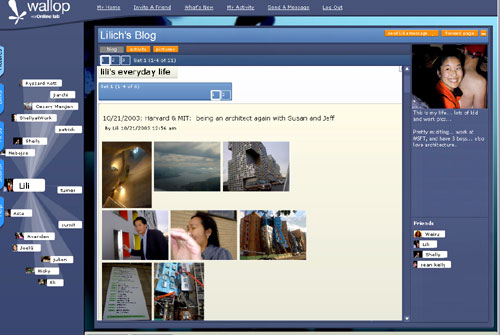 |
Microsoft spinoff Wallop launches test
Posted 9/26/2006 11:02 AM ET
The company, which aims to compete with established brands like MySpace and Facebook, plans to sell graphics and other features people can use to decorate their personal profile pages.
Wallop says the plan to charge users for the decorations will supplant the advertising that supports many such free sites. The add-ons will initially cost somewhere between 99 cents and $4, said Karl Jacob, the San Francisco company's chief executive. The company will offer some elements for free.
People will only be able to sign up for the service if an existing member invites them, an approach Facebook is about to abandon.
Wallop has its origins in a Microsoft research project that goes back several years. In the interim, News Corp.'s MySpace has emerged as a market leader in the now-hot field of forging and maintaining friendships online.
MySpace already lets users customize pages for free, though users typically have to find HTML code elsewhere to post into their profiles. Some visitors have complained that flashy icons and colorful lettering in such customized profiles can make them difficult to read.
Wallop, the social network where you pay for pretty
The "important" social network I mentioned in my post about Piczo is launching at DemoFall on Tuesday, and going into limited beta tonight. It's called Wallop. A lot of Wallop was developed inside Microsoft, but it's been spun out into a separate, venture-funded company, the thinking being that the small company will be able to do more with it, and more quickly, than Microsoft could. That's no lie: According to Wallop CEO Karl Jacob, Microsoft spent four years developing Wallop without actually releasing it to the public.
Wallop is different from other social networks in two important ways. First, it's all based on Flash (another reason it could never be a Microsoft product). That is both a blessing and a curse. Like Flash-based desktop suites DesktopTwo and Glide Effortless, it's beautiful. Pages look great, and the interface is much more inviting and interactive than on other HTML-based sites. There are some really gorgeous features, like a "radar" scope of your friends that brings the people you interact with the most closest to the center, while mere acquaintances are further away, and people you communicate with who are outside your network are farther still.
On the other hand, Wallop's Flash-based UI doesn't exactly follow standard interface protocols. It's not hard to use, but it's very different from other sites. It also doesn't work on cell phones. And forget about having a good experience if you have a slow network connection, like the one at the Demo hotel, where I'm writing this. Ouch.
The other big difference is the business model behind Wallop: If you can program in Flash or ActionScript, you can create widgets, or "mods," and sell them to other users; Wallop takes a cut of these transactions. For example, if somebody has a gizmo that automatically displays airfares to your hometown, you can't just pop it onto your Wallop page without buying it. You also can't use the growing library of HTML-based widgets like you can on a typical social net such as MySpace.
Will people pay for code to spruce up their Wallop pages? Certainly Jacobs is right that more people are expressing themselves through their online sites. He points to the growing ringtone market as proof that people will buy little bits of code to express themselves. And to the developing economies in virtual worlds like Second Life.
Wallop will have to be a lot better than other social networks before it becomes a place where people will pay to tart up their pages, but as I said, it's a beautiful site and it's built on a very clever model. I think it will work, although it's also likely that other widget marketplaces will develop soon (see Widgetbox) and I doubt they will limit use of their widgets to single network, like Wallop does.
Social-networking Web site Wallop launched in beta on Tuesday, offering such features as paid interactive graphics to polish up a person's profile page.
Wallop, which started as a Microsoft research project four years ago and then was spun out as its own company, is the latest social networking site to debut. It will compete with such heavyweights as Friendster and MySpace.com.
Wallop operates as an invitation-only network and offers free profile customization that doesn't require a person to delve into HTML code. However, people can also pay for interactive graphics and features called "mods," created by Flash developers and designers.
With its revenue model based on the assumption that people will want to doll up their profiles, Wallop is forgoing advertising, including pop-up ads, on its site.
"After taking a long, hard look at social computing, it became clear that it is not simply about the technology, which has been limited and plagued with problems to date," Karl Jacob, Wallop's chief executive, said in a statement. "It’s about the trend of self-expression moving online."
Wallop also announced on Tuesday a $10 million second round of venture capital funding, led by Norwest Venture Partners. Previous investors Bay Partners and Consor Capital participated in the funding round as well.
Microsoft also holds an equity stake in Wallop, which came out of the software giant's IP Ventures Program and research department.
Wallop will show off its beta test version at this week's Demo Fall '06 conference in San Diego.
